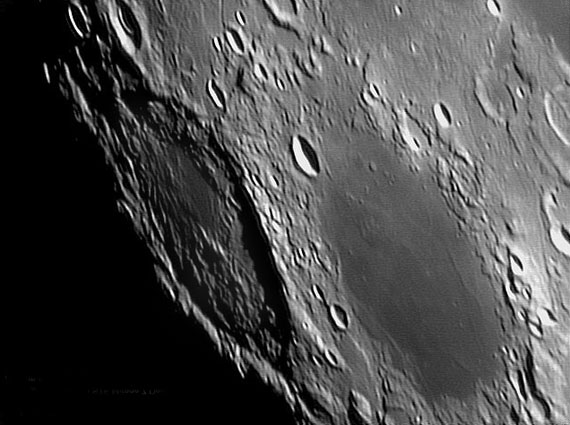October 10, 2004
Professor and Student
Image Credit: Mario Santiago |
|
Professor and Student Giovanni Baptista Riccioli was a 17th century Jesuit scientist who devised the system of names still used on the Moon. His nomenclature was displayed on a map constructed by his former student Francesco Maria Grimaldi. To commemorate their hard work, Riccioli named a crater after each of them, and modestly gave the larger to his student. The crater Riccioli (diameter 145 km) is striated with ejecta from the formation of the Orientale impact basin to the southwest. The lack of ejecta on the mare patch on the floor of Grimaldi (230 km) demonstrates that the lava flows there and the small patch in Riccioli erupted more recently than 3.84 billion years ago, Orientale's birthday. Crater counts suggest that the Riccioli mare leak is about 3.48 b.y. old and Grimaldi has ages of 3.25 and 2.50 b.y. This latter age is remarkably, perhaps even suspiciously young. More interesting to telescopic observers are details seen on the floor of Grimaldi. The large dome on the northern portion of the mare (circled on mouseover) is well known, and Mario's image also shows some smaller and steeper hills north of the big dome. Because these appear in the higher sun Lunar Orbiter IV view, these hills are most likely to be remnant pieces of Orientale ejecta that were not covered by the later lavas. But the largest of these hills (top one circled on the mouseover) is more complex - on the Orbiter image it looks like a steep-sided dome with small hills on its north and south edges. At the southwest edge of the mare there is a shadow (arrowed) which implies a relatively steep slope where the mare lava flows over the crater floor. Lunar mare lavas had a very fluid consistency, so it is always peculiar to find a steep slope - something was unusual there! Technical Details: Related Links: Tomorrow's LPOD: Fertility Central |
|
Author & Editor: Technical Consultant: Contact Translator: A service of: |
COMMENTS?
Register, and click on the Discussion tab at the top of the page.




